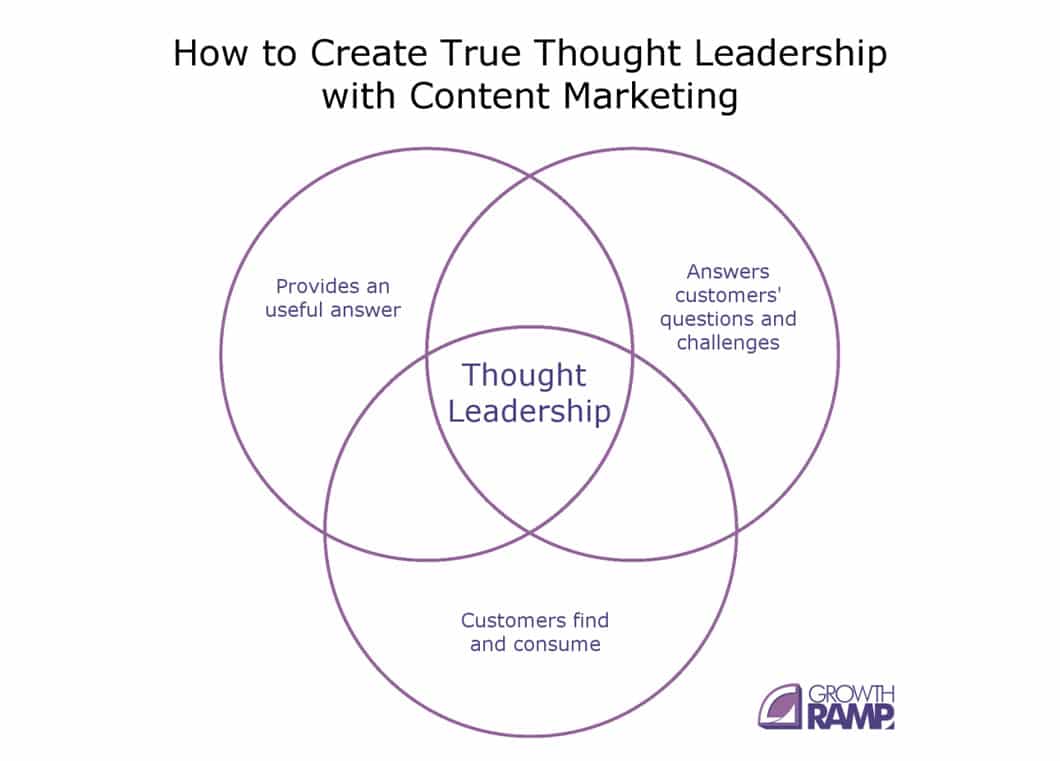You may be thinking: “What is thought leadership going to do for me that content marketing can’t?”
The answer: Thought leadership targets the people you really want to get a hold of — namely the decision-makers.
A LinkedIn study found 48% of decision-makers spent an hour or more reading thought leadership content and 89% said it enhanced their opinion of the organization.
It’s powerful stuff and we’ll cover everything you need to know to apply it to your business.
What Do We Mean by Thought Leadership?
Becoming a thought leader isn’t an overnight success story. A thought leader is an expert in their field, with innovative ideas and a full understanding of their industry, the key players and strategies to succeed.
Typically, this means the thought leader has obtained quite a bit of success themselves, as either the owner of their company or a high-ranking executive.

Thought leadership isn’t obtained by posting a few blog posts and opening a LinkedIn account. It’s a lifestyle. You need to have adequate experience in your field and the confidence to have your own opinions — and defend them.
Thought leadership is about having vision. That could be a vision for your industry, such as how Mark Zuckerberg revolutionized social media and continues to influence every major event in the industry. It could mean a vision for a better world, such as Martin Luther King Jr.’s social justice work.
Thought leaders use their skills and knowledge to build a community around their ideas and inspire others to take action for a common cause, or in their own lives.
3 Reasons Why Thought Leadership Is Important
1. Builds Trust and Your Reputation
Thought leadership is the perfect way to “show, not tell” your expertise. You demonstrate your competence through your content, which makes prospects much more likely to trust you.
A study by Edelman showed that 55% of decision-makers evaluate an organization’s thought leadership content when deciding whether to work with them.
2. Promotes Brand Awareness and Equity
Thought leadership is an effective way to build your brand. Your website, visual branding elements, social media and all that other stuff are important, too, but your content is the substance behind your brand.
Not only is having content great for search engine optimization (SEO) ranking, but unique thought leadership content especially builds your brand equity. Brand equity is the opinion people have of you that has tangible benefits, such as higher stock prices, more sales and increased customer loyalty.
3. Gets You In Front of the Right People
As previously mentioned, decision-makers are the ones who spend the most time engaging with thought leadership content. Specifically, those are C-suite executives (CEO, CFO, CMO, COO, etc).
According to Edelman, 47% of C-suite executives have voluntarily given their contact information to a person or organization after reading their thought leadership content. And, 60% of those executives also said they’d be willing to pay a premium price to companies with a demonstrated thought leadership vision.
Content Marketing vs. Thought Leadership

Content marketing:
- Provides value to the reader.
- Has a primary goal of driving sales.
- Can be either business-to-business (B2B) or business-to-consumer (B2C).
- Can be produced from the perspective of a company or an individual.
- Tends to cover a wider array of topics with a narrow focus.
Thought leadership:
- Provides value by introducing new ideas or methods.
- Has a primary goal of building credibility and trust.
- Is usually B2B-focused (though not always).
- Is usually authored under an individual’s name.
- Covers one topic or industry with a deep focus.
7 Ways to Use Thought Leadership to Grow Your Business
By now you know that true thought leadership needs to say something new. You need to have a new solution to an old problem or simply be such an expert in your field that others can’t help but take notice.
You can be the best artisan glassblower in the world, producing the most mind-blowing glassblowing content in the world. But if no one can find your content, you still aren’t a thought leader.
Combine these 7 strategies with your expert skill set and you have a recipe for authentic thought leadership.
1. Create a Consistent Schedule
You know that mythical place called Later, where all your best ideas and intentions live?
A content calendar keeps those great ideas from being stuck in purgatory forever by forcing you to write them. Consistency is important when you’re trying to build an audience from scratch.
An editorial calendar helps you organize topic ideas, plan ahead so you can produce your strongest work and lets your audience know when to expect to hear from you.
Your calendar can be as simple as, “Publish a new blog post every Thursday.” Or it can be as complicated as a 12-month planned-in-advance topic list, SEO research for each topic, when you need to draft it by, when it will be posted, social media promotion tips and more.
2. Include a Call to Action
You don’t want to beat people over the head with it like, “Buy my book here and now!” But, you want to direct your audience on what to do next. Chances are, if people are reading your thought leadership content, they are interested in your opinions and want to support you.
If you have a current offer like a book or course, link to it at the end of each piece.
You can include it in your mini-biography section, or as a line at the bottom of your article or video description.
3. Develop Content Around Your Audience
This seems basic but take a look at your current thought leadership content (if you have any). Are you talking about the things your audience is interested in or only what you’re interested in? Do those even overlap?
Are you trying to reach newcomers to your industry and help them be successful? Then your content needs to reflect those beginner-level questions they have.
You don’t need to overcomplicate this. What do people ask you all the time? What conversations are you having in person with employees and industry peers? Use that as a starting point for developing your content.
4. Research Your Audience
You need to know more about your audience than what topics interest them.
Invest the time (or hire someone) to research:
- Where your target audience spends time online: What social networks are they on?
- What is the best time and day to post on social media for your audience? Consider time zones, countries/locations and national holidays.
- Where does your target audience go for work? Trade shows, events, publications they read, etc.
- Where else can you reach your audience? Pay-per-click ads, sponsorships, event sponsorships, speaking engagements, partnering with another group, etc.
5. Keep a Narrow Focus
Thought leadership is about demonstrating mastery. It’s best to keep your content to only a few topics and go deep within those topics instead of trying to cover too much and watering down your expertise.
Seth Godin is one of the most popular business thought leaders and he’s a great example of narrowing down his focus. He mainly speaks about how leadership impacts all other areas of business. He writes short daily updates on his blog, longer articles on Medium and has written 20 bestselling books.
All of his content is centered around leadership skills, with more than 7,000 blog posts alone. His audience of millions knows exactly what to expect from him, which is the entire point of thought leadership.
6. Conduct Research
A big part of being a leader is contributing something new and never-before-seen to the conversation. Conduct a study on a topic in your niche. Hire a market research firm and report on the results. Or, survey your audience.
Sharing your own research not only adds to your credibility as an expert, but gets you a lot of shares. Social Media Examiner is a well-known site in the marketing industry and its original research projects earn thousands of shares and domain links.

You also can use original research to grow your audience. Or you can create a compilation of research by others (with proper credit, of course). Offer it as a free gift for signing up to your newsletter to quickly build your subscribers.
7. Measure Your Success
How you define success will depend on your goals for your thought leadership content. Do you want to get your brand out there and be well-known? To drive sales? To grow your social media following?
Those all may be things you want, but it’s best to focus on 1-2 main goals to start with. Write with the goal of making sales, if that’s what you choose. Then, measure the success of your content by how many sales result from it.
Whatever your metric is, write it down and record your growth every month.
Start Becoming a Thought Leader Today
Think you’re too small to start a thought leadership content plan? Chances are, you aren’t.
Thought leadership isn’t about your company’s size or how wealthy you are. It’s about helping others. That could be educating less experienced people within your industry to develop their skill sets. It could be educating your customers about your solution and how they can apply it to their situation. It can even be helping others with personal motivation and success training that could apply to many industries.
Whatever your focus, your goal is to be the best at it.
Provide the best answers, the most helpful content, the deepest knowledge, the freshest ideas and the most well-supported contrarian opinions.
Thought leadership — when done right — can boost your brand, grow your sales and provide other unexpected opportunities, such as speaking engagements and workshops. But if you’re going to do it, jump in with both feet and take it seriously. Your growth is waiting.













